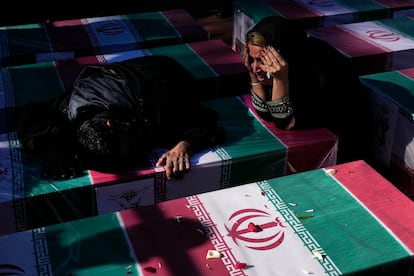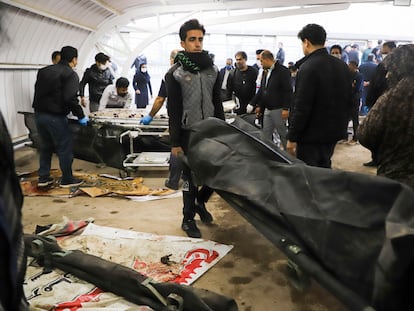The nightmare of the Islamic State resurfaces in Iran
The terrorist group maintains multiple affiliates with the capacity to carry out high-impact attacks, especially in Asia and Africa, despite its weakening in Syria and Iraq

When earlier this week all eyes were on the implications of the assassination of the Hamas deputy leader Saleh al-Arouri, in an attack in Beirut that bore all the signs of an Israeli action, two powerful explosions shook the Iranian city of Kerman. On Thursday, dispelling the confusion that had initially surrounded the events, the Islamic State terrorist group (ISIS) claimed responsibility for the attack, which killed at least 91 people and has become the deadliest in Iran’s recent history.
The attack — perpetrated in the midst of heightened regional tension caused by Israel’s devastating military offensive in Gaza — has put ISIS back on the map. It is the latest fateful reminder of its presence in different latitudes of the world and its ability to continue executing high-impact operations, despite having been defeated in Syria and Iraq — where it came to control large swathes of territory between 2014 and 2019 —, having lost many of its top commanders and leaders in recent years, and having been weakened by competition from rival groups.
In 2023, the number of attacks claimed by the Islamic State and its affiliates fell by 53% from the previous year, from 1,811 to 838, according to a BBC tally compiled from official communiqués from the group and its supporters. However, the organization remains capable of carrying out hundreds of attacks a year (more than two a day on average in 2023), exploiting local political and security vulnerabilities and loopholes.
A threat to Iran
The attack in the city of Kerman, when a tribute was being held for the anniversary of the death of General Qasem Soleimani, who was killed by a U.S. drone in 2020, was most likely perpetrated by the Islamic State of Khorasan Province (ISIS-K) branch. This subgroup of the organization was formed in early 2015 and operates mainly in Afghanistan and Pakistan, but also in some surrounding countries, such as Iran, and in recent years has been modifying its tactics and adapting its actions depending on the circumstances.
“Following the Taliban takeover in Afghanistan in August 2021, there was a marked increase in ISIS-K attacks. In response, the Taliban launched an extensive operation against its members and sympathizers, resulting in the death of dozens of people and the arrest of hundreds, and attacks decreased significantly,” says Abdul Sayed, an independent researcher focusing on jihadism in the region.
“However, in mid-2022, ISIS-K adopted a new strategy, focusing on large suicide bombings, rather than frequent mini-attacks, targeting foreign diplomats, foreign nationals, influential Taliban commanders, religious figures and key facilities in Kabul,” Sayed explains.
Between January and May 2023, the researcher adds, “the Taliban eliminated more than a dozen key ISIS-K commanders, leading to a drastic reduction in their attacks in Afghanistan and a prolonged cessation” of actions. In 2023, the group’s attacks plummeted 86% compared to the previous year and 93% relative to 2021, according to a BBC tally.
Nevertheless, the group’s most active operational network is currently located, according to Sayed, in the Bajaur tribal district of northwestern Pakistan bordering Afghanistan. The expert says that “details about the whereabouts of ISIS-K leaders and members remain elusive,” but notes that Taliban intelligence operations suggest that cells exist in Kabul, in a northeastern province bordering Pakistan, and in northern provinces bordering Tajikistan and Uzbekistan. There are also indications of their presence in the western province of Herat, bordering Iran.
Some analysts have warned that, due to increased anti-terrorism pressure from the Taliban, ISIS-K may have opted not only to commit fewer — albeit more powerful — but also more regional attacks. In this regard, Iran faces the most danger, due to the radically anti-Shiite stance of ISIS (which is a Sunni Muslim militant group), its opposition to the Iranian authorities, and its scope for recruiting followers among Iranian Sunni citizens opposed to the government in Tehran. Moreover, Iran has neither the influence nor the like-minded militias in Afghanistan that would allow it to confront ISIS-K, as is the case in Iraq and Syria, through the various pro-Iranian armed groups and the proximity to the government of Bashar al-Assad.
The Kerman attack is not the only recent wide-ranging attack by ISIS, nor its first major attack on Iran. Last summer, the group killed more than 60 people and wounded more than a hundred in another suicide bombing executed during an election rally in Pakistan. In October 2022, the terrorist organization took responsibility for another attack in the Iranian city of Shiraz that left more than 10 dead and dozens wounded. In 2018, it claimed responsibility for an attack during a military parade in the southwestern Iranian city of Ahvaz that killed 25 people. And a year earlier it hit central Tehran with two attacks, against the Iranian Parliament and the mausoleum of Ruhollah Khomeini, the founder of the Islamic Republic of Iran and the leader of the Iranian Revolution, in which 18 people were killed. Iranian authorities have accused the Islamic State of other attacks in the country, and claim to have thwarted dozens.
Global network
In addition to the province of Greater Khorasan (which in jihadist terminology refers to the historical region that includes present-day Afghanistan, eastern Iran and parts of Tajikistan, Turkmenistan and Uzbekistan), the Islamic State maintains multiple affiliates in other parts of the world that remain active. In Iraq and Syria, the ground has had to mutate the most in recent years due to factors such as the strengthening of the Syrian regime and the Iraqi military apparatus; its loss of territory, influence, resources and recruits; and the rapid elimination of its leaders. Last year, its claimed attacks in Iraq fell 65% from 2022, and in Syria, 60%. However, the group remains capable of executing dozens of attacks, including particularly sophisticated ones such as those it has carried out in Syrian prisons to free members of its ranks, and continues to exploit security and stability gaps in areas such as central Syria to strengthen itself.
The situation is markedly different in sub-Saharan Africa, where the Islamic State has five regional branches and has sought to expand its influence in recent years to counter setbacks in the Middle East. There, the group has exploited the region’s increased instability and reduced counter-terrorism pressure resulting from multiple coups, especially in the Sahel region, coupled with political and socio-economic grievances of the local population.
In 2023, attacks by the different branches of the Islamic State in sub-Saharan Africa were also down compared to the previous year. But the region accounted for up to 60% of the total number of attacks claimed by the group worldwide. Its most active affiliates are those in West Africa, mainly in northeastern Nigeria and around Lake Chad, and the Sahel, especially in Mali. Its provinces in Central Africa and Mozambique also pose a notable threat.
In Egypt, where the Islamic State’s Sinai branch went so far as to take responsibility for more than 100 attacks in 2022 and to occupy some locations temporarily in 2020, the threat has been almost completely crushed.
Sign up for our weekly newsletter to get more English-language news coverage from EL PAÍS USA Edition
Tu suscripción se está usando en otro dispositivo
¿Quieres añadir otro usuario a tu suscripción?
Si continúas leyendo en este dispositivo, no se podrá leer en el otro.
FlechaTu suscripción se está usando en otro dispositivo y solo puedes acceder a EL PAÍS desde un dispositivo a la vez.
Si quieres compartir tu cuenta, cambia tu suscripción a la modalidad Premium, así podrás añadir otro usuario. Cada uno accederá con su propia cuenta de email, lo que os permitirá personalizar vuestra experiencia en EL PAÍS.
¿Tienes una suscripción de empresa? Accede aquí para contratar más cuentas.
En el caso de no saber quién está usando tu cuenta, te recomendamos cambiar tu contraseña aquí.
Si decides continuar compartiendo tu cuenta, este mensaje se mostrará en tu dispositivo y en el de la otra persona que está usando tu cuenta de forma indefinida, afectando a tu experiencia de lectura. Puedes consultar aquí los términos y condiciones de la suscripción digital.
More information
Archived In
Últimas noticias
Most viewed
- Sinaloa Cartel war is taking its toll on Los Chapitos
- Oona Chaplin: ‘I told James Cameron that I was living in a treehouse and starting a permaculture project with a friend’
- Reinhard Genzel, Nobel laureate in physics: ‘One-minute videos will never give you the truth’
- Why the price of coffee has skyrocketed: from Brazilian plantations to specialty coffee houses
- Silver prices are going crazy: This is what’s fueling the rally











































